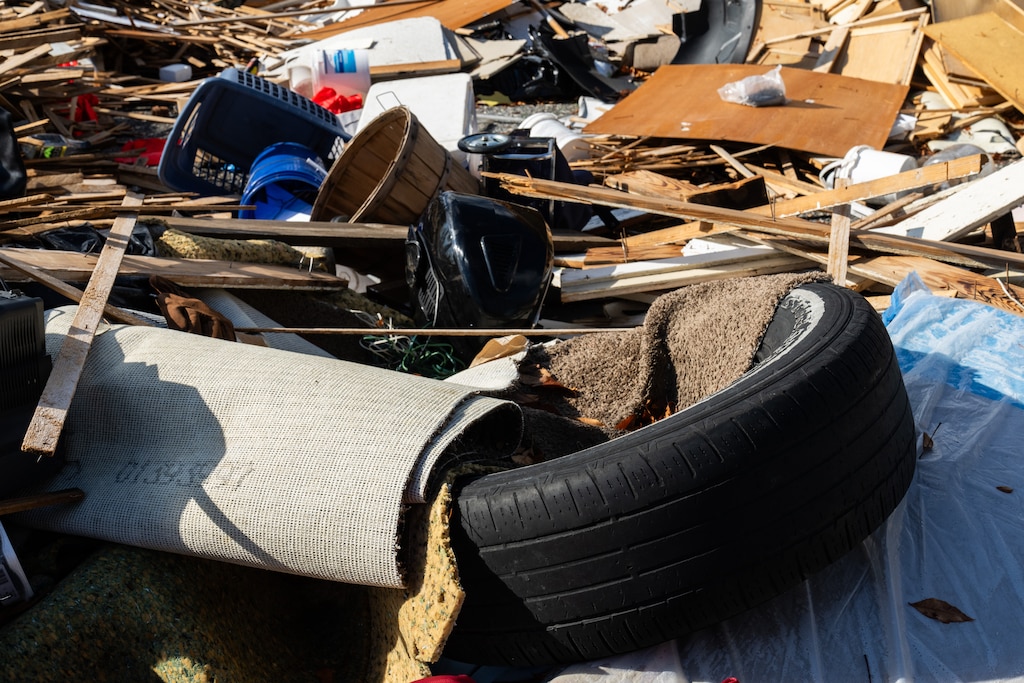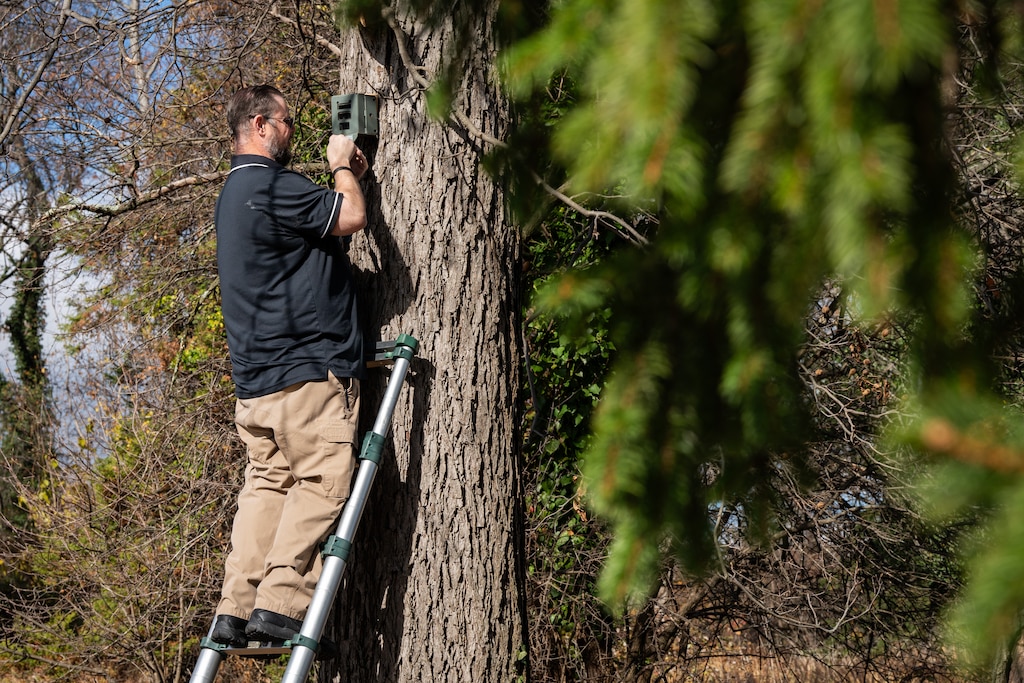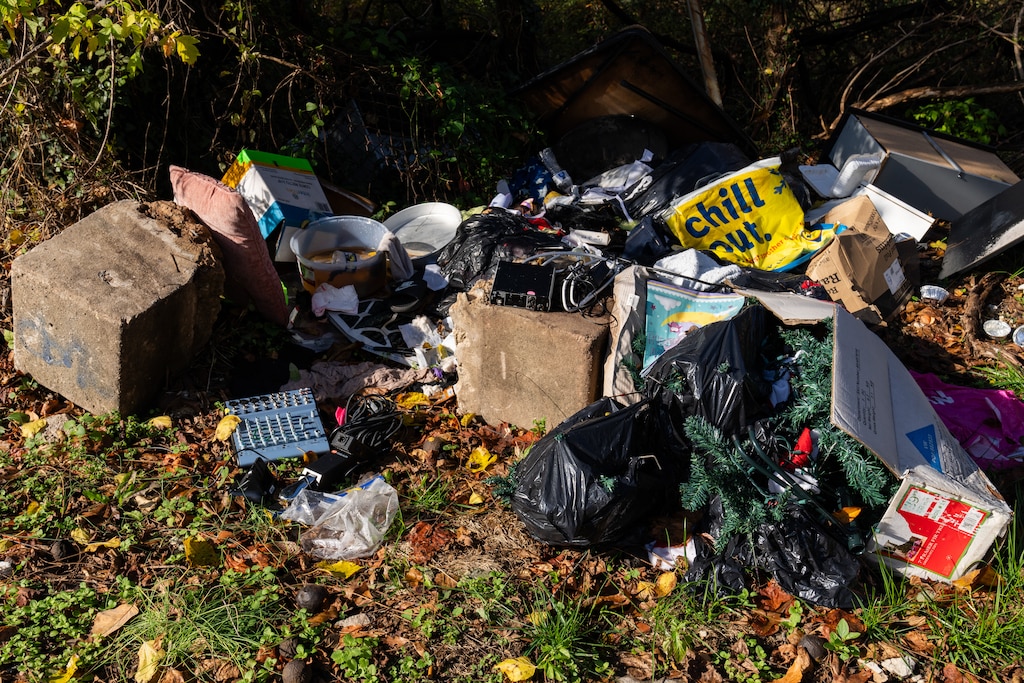The first step of investigating an illegal dump in Baltimore City is to deliver a soft kick with the toe of your shoe to any item worth inspecting up close. David McGinnis says this gives any rats taking shelter underneath a chance to scurry out.
On a mild November Wednesday, at the tip of a secluded, hilly crest tucked away in a residential neighborhood on the city’s west side, McGinnis spends a few minutes softly kicking his way around the dumping ground. It takes about as long for the director of the special investigations unit at the city’s Department of Housing and Community Development to deliver the verdict:
This was the work of a house flipper.
How does he know? The disposed hot water heater, wooden slats, kitchen sink and 1970s-era décor suggest that someone gutted a property from head to toe. The wood remains free of water damage — the sign of a fresh dump — and there’s evidence that the house had been infested with termites due to the pattern of vertical lines chewed into the slats.
The Baltimore Banner thanks its sponsors. Become one.
One of the Amazon bags tossed among the rubble bears a woman’s name; whoever dumped the items didn’t think to remove the label. McGinnis copies down her address.
Sometimes these clues lead to people who have an idea how their belongings ended up discarded this way. More often they’re just a debris-filled dead end.
Read More
And if so, McGinnis, a code enforcer for nearly a decade and the chief of the special investigations unit for the past two years, has a powerful new tool he can use: a small, fist-sized camera camouflaged discreetly on the hill that may have captured the dumper’s license plate or the vehicle make and model.
Since August, the city’s housing department has increased its inventory of cameras meant to capture illegal dumpers from 70 to 100. Even before deploying them all, the agency saw an immediate uptick in the number of dumping incidents they can now investigate and prosecute. Within a few weeks, the new, high-tech cameras — the kind a hunter or biologist might use to surveil wildlife — captured video evidence of 15 illegal dumpers. In the six months prior to the cameras’ installation, the unit identified seven people by camera.

In a cash-strapped city with a long list of priorities, the dumping sprees add yet another mess for Baltimore officials to clean up — and, of course, pay for. More than 13,000 such incidents are reported to the city’s 311 unit every year, a number that’s remained stubbornly consistent over time.
The Baltimore Banner thanks its sponsors. Become one.
Those who live in Baltimore know well the headaches that can stem from illegal dumping, a public nuisance that can attract animals and pests, cause unsavory odors and set off a chain reaction that produces more blight. Neighborhood leaders have complained of the burden a dump can impose on them and of the impression it imparts on passersby. And it can take days for city crews to clear the sites.
Jason Hessler, deputy commissioner for permits and litigation for the city’s housing agency, said out of the initial 15 perpetrators caught on tape with the new cameras, four people have either pleaded or been found guilty. A guilty verdict can impose fines, community service or, in some cases, imprisonment for repeat offenders.
Without the cameras, the dumpers may have received a citation or no penalty at all. And investigators may have spent more time sifting through trash, chasing down leads and hunting for other clues to tie the cases together.
“The additional cameras make us more effective,” said McGinnis, who oversees a team of 10 investigators, with more to onboard soon. “The [vehicle] tags give us something actionable.”
City officials have attempted to discourage illegal dumpers in the past. They’ve levied citations and fines upon those even tangentially mixed up in the crime, published a “hall of shame” online and sought tougher penalties for those convicted. And yet, the dumpings persist.
The Baltimore Banner thanks its sponsors. Become one.
With more and better video evidence, city leadership said they already are seeing some promising results.
Year to date, the city has filed 23 cases. Thirteen ended in conviction and four are awaiting trial dates, McGinnis said. There are two open warrants, and a few other cases were dropped or dismissed.
Hessler acknowledged the department’s new high-tech additions won’t eradicate the city’s illegal dumping problem entirely. But in the areas where the dumpers have been sanctioned, the number of incidents has dropped, he said.
“We want to send a message that it’s not acceptable to dump in Baltimore City,” Hessler said. “We have landfills, bulk trash collection, regular trash collection, and a lot of opportunities to repurpose things like Second Chance [Inc.] and Goodwill for things to be donated, instead of getting into the waste stream.”
Cameras have been used to attempt to crack down on unlawful dumps since 2009, but Hessler said there hasn’t been enough of them to capture every blind spot. Over time, technology has only improved and become more accessible. The new cameras are cloud-based, motion activated and battery powered, which has dramatically enhanced the quality of the footage and cut costs. Each prices out at under $1,000.
The Baltimore Banner thanks its sponsors. Become one.

The city purchased the cameras as part of Mayor Brandon Scott administration’s 90-day city service “sprints,” a seasonal push for agencies to set goals to tackling specific problems. Scott has referred to the sprints as a show of force — “to strengthen service delivery and keep our city clean and safe,” he said in a news release earlier this year.
Though illegal dumping had been an agencywide priority before the sprints, Hessler said, the additional resources have helped bolster the work.
“Nobody wants trash sitting around,” Hessler said. He declined to share the exact locations of the cameras but said they were dispersed throughout the city in all but one City Council district. Generally, they are affixed in areas that don’t see much foot or vehicle traffic: dead ends, alleyways, industrial parks.
Hessler said those who dump in Baltimore come from near and far.


Most often, the dumpers are contractors or small haulers who may have worked late into the night and not had time to find a proper disposal site before the next job in the morning. Sometimes they are landlords hastening an eviction process — children’s report cards and sensitive paperwork have been found among the rubble, Hessler said — or tenants under pressure to leave their homes with nowhere else to store their belongings.
The Baltimore Banner thanks its sponsors. Become one.
As for the dumps themselves, Hessler and McGinnis said the contents vary. They’ve seen everything from landscaping waste to tons — and tons — of tires, which are not as easily recycled anymore due to a growing body of environmental and health concerns about their reuse. They’ve recovered bowling pins, mannequin heads, VCR tapes, vinyl records. A few times, they’ve found dumped sailboats, which may have been stripped off more valuable mobile trailers and left behind.
“A lot of people don’t know what they’re throwing away,” McGinnis says at the West Baltimore dump site, surveying the heaping piles of waste. After scoping out the rest of the site for more clues, he makes a note to check the camera footage and see about adding a fence at the foot of the hill. If you can’t catch them, deter them, he says.
Then he sets off — it’s a little after noon, and he’s got a vacant house to board. “The work never stops.”
Correction: This story’s photo captions have been updated with the correct day of the week that the images were captured.





Comments
Welcome to The Banner's subscriber-only commenting community. Please review our community guidelines.